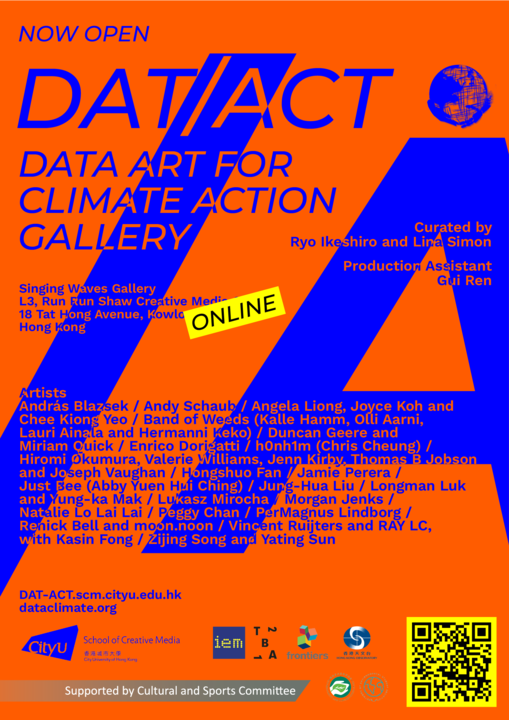DAT/ACT Data Art for Climate Action Gallery
Exhibition
23 Feb
22 May 2022
All events online, HKT.
|

|
Welcome to join the online opening on 23 February, 19:00-19:30.
Please register for free here to receive the Zoom link: https://dataclimate.org/registration/
DAT/ACT DATA ART FOR CLIMATE ACTION GALLERY
Curated by Ryo Ikeshiro and Lina Simon
Production Assistant Gui Ren
ARTISTS
András Blazsek / Andy Schaub / Angela Liong, Joyce Koh and Chee Kiong Yeo / Band of Weeds (Kalle Hamm, Olli Aarni, Lauri Ainala and Hermanni Keko) / Duncan Geere and Miriam Quick / Enrico Dorigatti / h0nh1m (Chris Cheung) / Hiromi Okumura, Valerie Williams, Jenn Kirby, Thomas B Jobson and Joseph Vaughan / Hongshuo Fan / Jamie Perera / Just Bee (Abby Yuen Hui Ching) / Jung-Hua Liu / Longman Luk and Yung-ka Mak / Lukasz Mirocha / Morgan Jenks / Natalie Lo Lai Lai / Peggy Chan / PerMagnus Lindborg / Renick Bell and moon.noon / Vincent Ruijters and RAY LC, with Kasin Fong / Zijing Song and Yating Sun
EVENTS (online, HKT/UTC+8)
Wed, 23/2
19:00-19:30 Exhibition Opening
19:30-20:20 Audiovisual Event 1 (Angela Liong, Joyce Koh and Chee Kiong Yeo / Hongshuo Fan)
Thurs, 24/2
21:00-21:40 Audiovisual Event 2 (Enrico Dorigatti / Duncan Geere & Miriam Quick / Longman Luk & Yung-ka Mak)
Fri, 25/2
21:00-22:15 Audiovisual Event 3 (Algorave: Renick Bell and moon.noon / Just Bee (Abby Yuen Hui Ching)
Sat, 26/2
16:40-17:40 Artists’ Session
CURATORIAL STATEMENT
DAT/ACT brings together a collection of artworks responding to climate change, the defining crisis of our time. Perhaps a contraction at first glance, the title is open to interpretation and visitors may detect a variety of possibilities in both meaning and pronunciation. Should it say “DATA”? Is the data incomplete? Does it contain an imperative, a command to “act”? Or does it refer to a written law, as in an Act of Parliament? Should it rhyme with “tact”? Is it an abbreviation of “ACTION”? Does it indicate something performative? Does the “/” mean that it is an either/or statement? Should we choose one or the other?
Many of the works use data as material through visualisation and sonification, the process of presenting data and information through graphical means and non-speech sounds respectively. These techniques can serve a didactic purpose by conveying the science and data behind climate change. But their use in an artistic context can progress beyond merely being visual and auditory display or a formalist exercise. How the data is communicated via the audio and the visuals becomes inseparable from the aesthetic concerns of the sound and the moving image.
What is required in comprehending the title and the works in the exhibition is not necessarily any missing “data” – the evidence behind climate change is overwhelmingly clear – but perhaps a response on the part of both the artist and the viewer/listener in order to supplement the context conveyed. This response or “act” is not merely a direct call to action which leads to practical outcomes – the works presented are not only a way of raising awareness of a worthy cause, nor simply a form of agitprop or activism. After all, exhibiting works on the subject of climate change in a gallery setting could quite rightly be considered as preaching to the converted at best, cynically riding on a wave of popular sentiment, or worse. Rather, what is necessary is a consideration of how artists can engage with the topic of climate change, and how the viewer/listener can in turn engage with such artworks. The act required becomes a form of interpretation or reflection, or the formation of subjectivity, in experiencing the association of sensory affect with the context of climate data and its real-world implications.
Questions to consider could include the following:
How do you enjoy a piece of music when its upward trajectory is thanks to global warming?
How pleasing to the eye can an image showing carbon emissions increase be?
How apparent should the data be in audio and visual patterns generated by climate data?
How amusing should a satirical take on climate change be?
Should the success of this exhibition be assessed in terms of behavioural changes in the visitors to the gallery or the wider public? (No)
Should you make an effort to reduce your carbon footprint after visiting this exhibition? (Yes)
DAT/ACT asks visitors to consider the possibilities of “data art for climate action,” its limits and how to exceed them.